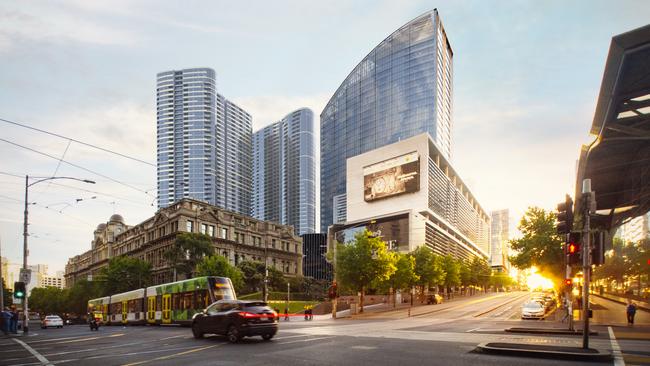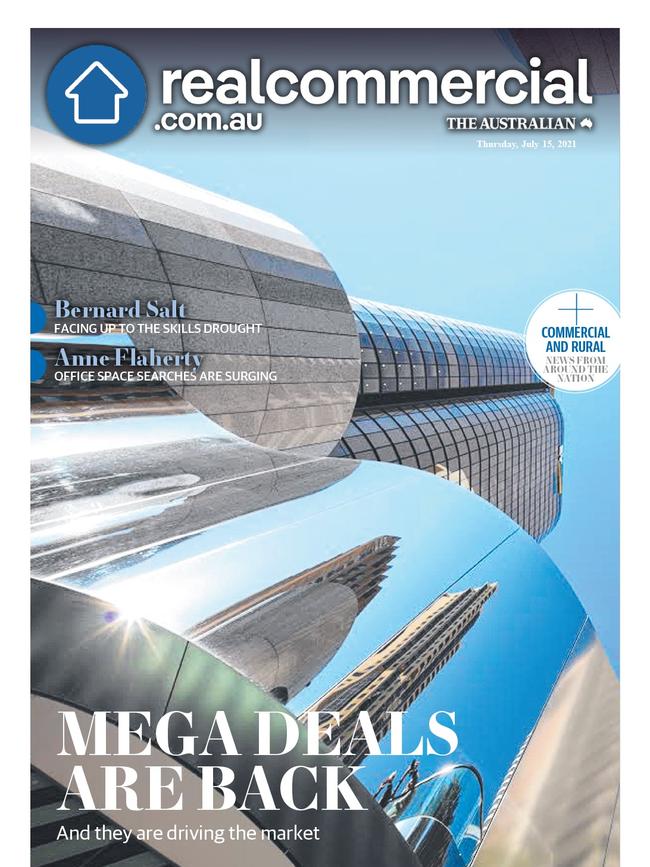Hot real estate: Mega deals drive the market … and they’re not slowing down
Big global investors have set the pace this year and they show no sign of cooling their jets as commercial property booms.

Property mega deals are back. The commercial property market has come through the pandemic with wheeling and dealing back in vogue even in virtual meeting rooms.
Australia’s commercial property market has more than survived the searing worst of the pandemic and close to $17bn worth of assets traded in a busy first half.
And more is expected this half with the focus both on the rising logistics sector and, increasingly, office assets, with breakthrough deals also occurring in shopping centres.
Capital has come from all around the world and in many cases is chasing ever-larger deals.
The half was defined by Asian logistics group ESR picking up the Milestone property portfolio for $3.8bn and South Korea’s National Pension Service swooping on the new $1.2bn Medibank headquarters in Melbourne.
NPS has had the appetite for major Australian deals since picking up Aurora Place in Sydney after the global financial crisis for $685m.

NPS head of real estate investment division Scott Kim said the company’s strategy was to acquire premium quality commercial assets with high sustainability features.
“The COVID-19 pandemic is accelerating flight to quality trends in the office sector and this asset fits our strategy to invest in the highest quality buildings in desired locations with strong tenant demands,” he said.
The transactions are of a scale even larger than some listed real estate investment trusts. These super scale plays are no mistake.
In many cases, global pension funds are making a decision to go with fewer managers when they place huge licks of capital. In other situations, property platforms want to rapidly gain scale and are prepared to pay up for it.
Funds manager Logos has just acquired the Moorebank Logistics Precinct from operator Qube for $1.67bn. It was backed by AXA IM Alts, Australian Super, Ivanhoé Cambridge and NSW’s TCorp.

AXA IM Alts head of Australia Kumar Kalyanakumar said the acquisition broke new ground not just for Australian logistics, but the region, and pointed to advances in automation and energy technologies embedded in the complex deal.
“AXA IM Alts is a long-term conviction-based investor, and this investment aligns well with the business’ ‘beds, sheds and meds’ investment strategy in both Europe and Asia Pacific, with the precinct offering unique exposure into a sector that was already attractive before the pandemic, but which has further grown in appeal as a result of structural trends accelerated by COVID-19,“ he said.
Colliers International managing director, capital markets and investment services John Marasco says there has been a shift away from some asset classes and move into the star performers.
Despite borders being closed he says that global capital is investing in Australia at unprecedented levels, partly on the back of the nation’s recovery but also as global investors search for yield and stable returns.
Many are also fund managers who are chasing large scale and specialisation in what they are doing in order to generate high returns.

Mr Marasco said there was also record corporate sale and leaseback activity to free up capital for reinvestment into core business, which suited big institutions looking for deals.
Knight Frank head of institutional sales, Australia, Ben Schubert, said that larger transactions had been a feature of the year, whereas there had been fewer deals in the smaller institutional bracket.
He said that part of the rationale lay in the strategy of groups that were vending assets after years assembling portfolios. Private equity groups often plan exits via floats or portfolio sales and developers also need capital partners for their ever-larger deals.
Mr Schubert expects the dam to break for offers of up to $100m but points to some constraints. “The dearth of transactions is a combination of owners experiencing phenomenal growth in their assets over the last few years and believing in the longevity of this growth due to the sheer depth of capital chasing product,” he said.
He is most optimistic about assets that are being sold with repositioning potential.
“The most significant trend of recent times is the propensity for investors to take on risk appearing to increase. The depth of capital for core product has remained strong through the COVID-19 period, however those assets with significant risk in terms of leasing or capex were being discounted,” he said.
But he backs the thesis that a “go big or go home” trend will most definitely continue into 2022 with the likes of Charter Hall, Centuria and Lendlease looking to add to their portfolios and satisfy the thirst of their cashed up capital partners.
“On the vendor side of the equation, we’re seeing active sellers of large scale institutional grade assets in most markets, particularly Sydney and Brisbane and look for Melbourne to bounce in terms of the availability of stock through the back end of 2021,” Mr Schubert said.
Mega deals spiked in 2019 and 2021 are already getting close to 2020 levels, according to analysis by JLL. The firm’s figures for mega deals covering sales in the office, retail and industrial markets of more than $400m showed a steep rise.
JLL head of capital markets, Australia, Fergal G Harris, said the trend towards larger transactions was becoming more prevalent.
“We started documenting the rise of the mega-deal, defined as those in excess of $400m, pre-Covid, he said.
“The drivers for these mega-deals are the multiple capital sources looking for and competing for assets that can provide scale, as well as the portfolio tilt towards the Asia Pacific region, as European and North American investors seek geographical diversification in their real estate portfolio,“ Mr Harris said.
He says local markets are the prime target.
“Australia, alongside other mature markets like Tokyo and Singapore are initial preferred targets and Australia remains attractive,“ he said.
CBRE head of capital markets, Pacific, Mark Coster said there is a growing set of institutional investors globally seeking to deploy amounts of capital into transactions of scale.
He says that as the Australian commercial property market has matured, global players like Nuveen, Oxford Properties Group and GIC have established themselves.
“They’re not here for one deal,” he said. ”The next deal has to be bigger for it to move the needle.”

Mr Coster says the capital that global players are bringing to the market is crucial for the growth of both traditional areas and emerging sectors. “We need them in direct deals and investing indirectly into our funds and as a source of alternative debt finance,” he said.
Mr Coster cites growing interest in areas ranging from data centres and life sciences to build-to-rent and said larger investing was also spinning off opportunities for local investors.
McVay Real Estate head of office investments Rob Sewell harks back to when Australia was discovered after the global financial crisis by international investors. Other parts of Asia like Tokyo, Singapore and Hong Kong were much harder to crack, while Australia’s reputation grew.
But eager international investors were often disappointed by the lack of scale in Australia to allow them to “pin their ears back” and bid aggressively. This is now changing with a new set of rules coming into play for mega assets.
“In Sydney and Melbourne scale is what attracts the mega buyer and they know a premium for control will need to be paid. Prime office trophies such as the $1.5bn 80 Collins Street Melbourne attracted new capital that we hadn’t seen previously due its scale,” Mr Sewell said.
The chance to grab full control of an asset is critical.
“The prized Chifley Tower in Sydney saw wealthy buyers from Hong Kong circling hoping for an opportunity to prize out a 100 per cent interest and freehold for almost $2bn but couldn’t as 50 per cent was the preferred trade,” he said.
For assets worth more than $1bn there is another group of investors who are using these assets as seed assets to create new platforms.
Against this backdrop he says prime office assets in Sydney and Melbourne even with leasing risk will sell. This was proved by CIC swooping on a half interest in Grosvenor Place for $925m despite having a third of the building vacant in 2023 when Deloitte leaves.
“These investors know when these assets become available you cannot be choosy as to whether now is a good time to buy it – you just buy it as you are investing for the long term,” he said.
Mr Sewell also points to the inflation of values over the long running commercial property boom, saying that markets like North Sydney now have assets worth more than $1bn. And definitions may need changing.
“My mega deal size is $500m or above but more likely over $700m,” he said.








To join the conversation, please log in. Don't have an account? Register
Join the conversation, you are commenting as Logout